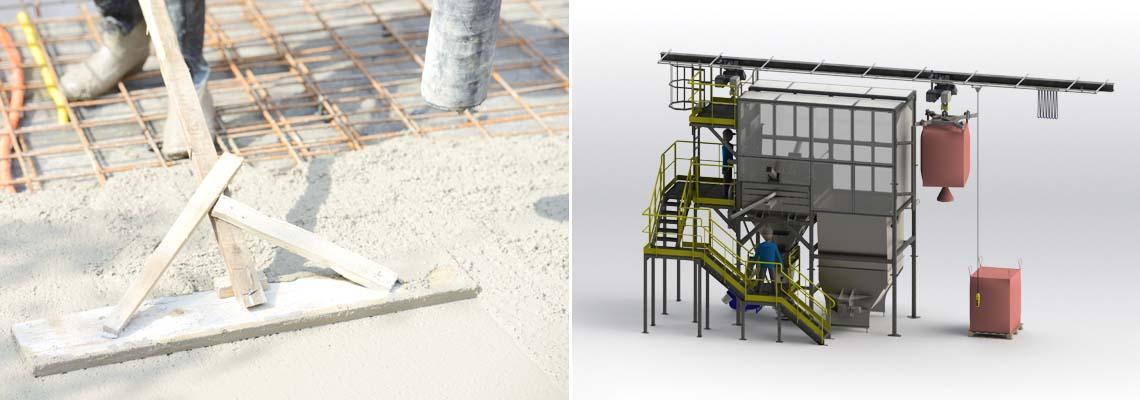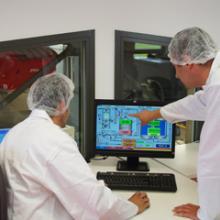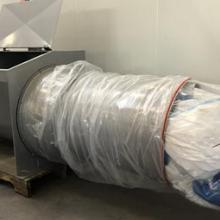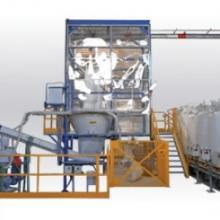Process Powders: cement
Cement deconditioning
Automous big bag unbloading systeme for the cement industry
Our client, is a provider of construction materials and contracting services in the western, central, and southern U.S. They needed to improve upon their existing manual handling and emptying operations for flexible totes and super sacks filled with 1 ton of cement powder. The current process was labor intensive and needed a safer means of material handling for improved operator ergonomics and production efficiency.
The industrial solution :
Our team of powder handling experts reviewed and recommend the Palamatic Process Easyflow® EF200 bulk bag unloading production system for the handling of cement powders. This bulk material handling system provides all the necessary functions required to meet a more automated manufacturing process, including: transfer, lifting, loading, opening and compaction of bulk bags. The production rates of this system were designed to meet an unloading pace of 17 bulk bags per hour. But this could be increased with careful design if necessary.
Equipment functions :
- Bulk Bag Transfer System
- Lifting, Loading and Opening
- Waste Removal and Compaction
- Automation
Bulk bag transfer System
To start the sequence of this FIBC emptying system, the forklift operator first loads the flexible container resting on its pallet onto the mechanical roller conveyor. Once secured, the operator signals the system via touch screen controls to begin the transfer process. The motorized roller conveyor safely moves the bulk bag down the production load to a staging area. Sensors tell the controls when the bulk bag is in place and stop the motorized roller conveyor.
The technical characteristics of the roller conveyors are as follows:
- Load capacity: 1500 kg for every 3.3 meters of conveyor length
- Steel rollers: 9 cm, length 130 cm
- Fully fenced chain bracelet and double sprockets
- Power supply: 3 phase / 480V
- Speed: 9 – 18 meters feet per minute
- Structure is mild steel with galvanized steel rollers
The transfer system also includes an automated pallet stacker. Once the bulk bag is lifted from its pallet, the motorized roller conveyor re-directs it to a pallet stacking unit. The capacity of the pallet stacker can be arranged between 15 to 20 pallets, and once filled, a forklift operator can open the unit and remove the stack of pallets. The stacking rate is equal to 250 pallets per hour.
Lifting, loading and opening of the bulk bag
Once the sensors have communicated to the main HMI control panel that the bulk bag is in position, an operator attaches the bulk bag handles to an automatic electrical hoist and hanger system. Once the bulk bag is secured, the operator approves the next cycle steps.
The bulk bag hoist lifts the container into the air where a motorized trolley hoist horizontally transfers it from the staging area to the unloading area.
Once the electric chain hoist is positioned above the discharge hopper, it lowers it onto a serrated puncture blade.
There, the system uses the weight of the bulk bag on the burst spikes and u-shaped blade. This design creates a 3-sided cut in the bottom of the FIBC, causing the fabric to open like a flap. Even materials with stubborn flow properties can easily discharge from the bulk bag due to a larger opening that the typical tied spout diameter would not allow.
Nonetheless, massage paddles can be integrated into the unloading station to create a squeezing action on the sides of the bulk bag to help break up any material bridging or rat-holing issues. A buffer hopper with an elastomer containment skirt collects the cement material and contains any free-floating fine particulates, preventing a dusty atmosphere.
Nozzle ports on the upper exterior of the hopper allow for connection to a central dust collection system. This allows for further protection of dust escaping during the pouring out of the bulk bag contents. The buffer hopper is made of epoxy coated carbon steel and offers 1500 liters of storage capacity. The burst spike for opening bulk bags is connected to a pull-out drawer design to allow for removal of the blades for the purpose of maintenance and sharpening procedures.
Bulk bag waste removal and compaction
Once fully emptied, the electric hoist on its trolley moves the FIBC waste to a secondary hopper. The automated bulk bag handling cross hooks release the empty bulk bag via the automatic control system. The bulk bag falls into the secondary hopper that funnels into a bulk bag compactor unit. As the bulk bag falls into the compactor, a large auger grips and pushes the FIBC into a compaction tube. On the exterior of the tube is a plastic sleeve held in place by two rubber tension rings. As more bulk bags pile up on the compaction tube, they push the plastic sleeve outward (think similar concept to stuffing sausage links). As the sleeve grows, an operator twists the sleeve to form a link. He then zip ties the other end of the sleeve twice and cuts in between the two ties. With this method, the next link is formed and the old link is fully contained and can be discarded in the plant’s main waste compaction unit or trach collection bins.
Automation
The PLC was designed by our inhouse automation and electrical team. The control cabinet was made of an epoxy coated mild steel with a 7” touch screen. The PLC type is a Siemens S7-1500SP with Profinet communication.
The system was responsible for the management of the following operation cycles :
- Automatic management of the bulk bag roller conveyor system (buffer and advancement).
- Automatic empty pallet transfer and stacking.
- Automatic transfer of the loaded bulk bag by the handling cross mounted on a motorized hoist trolley.
- Automatic bulk bag opening and emptying over buffer hopper.
- Automatic transfer + release of the bulk bag into the bulk bag compactor.
- Compaction of the bulk bag into a plastic sleeve.
- Automated return of the handling cross to original position for the next bulk bag.
Palamatic Process also offers remote diagnostic capabilities by integrating an ethernet remote maintenance box. This allows our team to remotely diagnose and troubleshoot any system errors or malfunctions in real time. Palamatic Process designs, assembles and programs all controls panels in-house. Our automation engineers include user friendly raw material inputs, lot traceability, operator identification and more. The PLC handles and controls the bulk bag emptying, pallet stacking, conveying, and hopper selection. Our technicians visited the client’s site with the delivery of the equipment to provide supervision, commissioning and training of the client’s staff.
Palamatic Process has been supplying the powder and bulk solids industry with bulk bag handling equipment since 1992. In order to determine what solution is best for your project, contact one of our sales engineers. Together, our team of experts can provide the right kind of bulk bag unloading equipment that will meet your production goals.

















